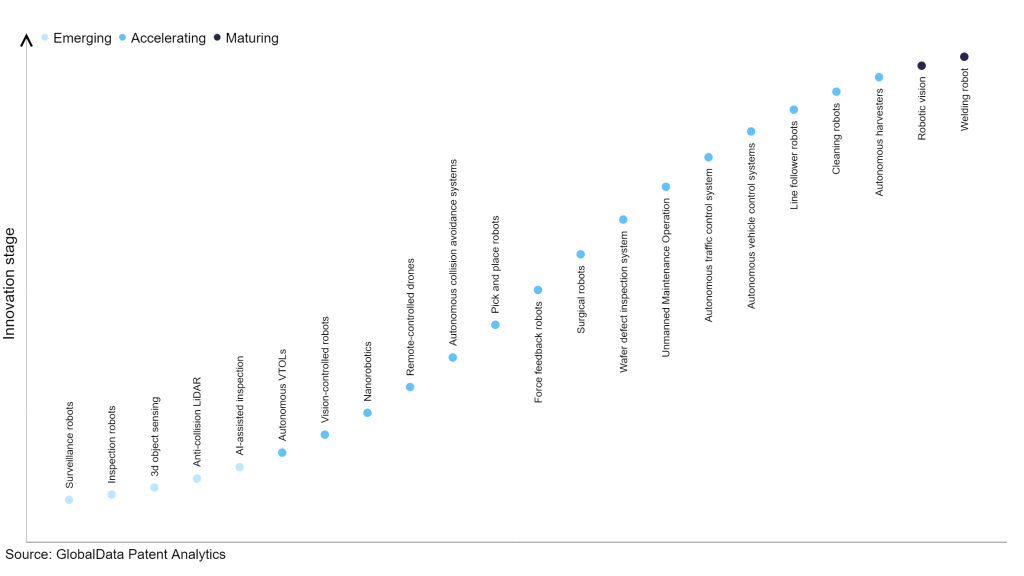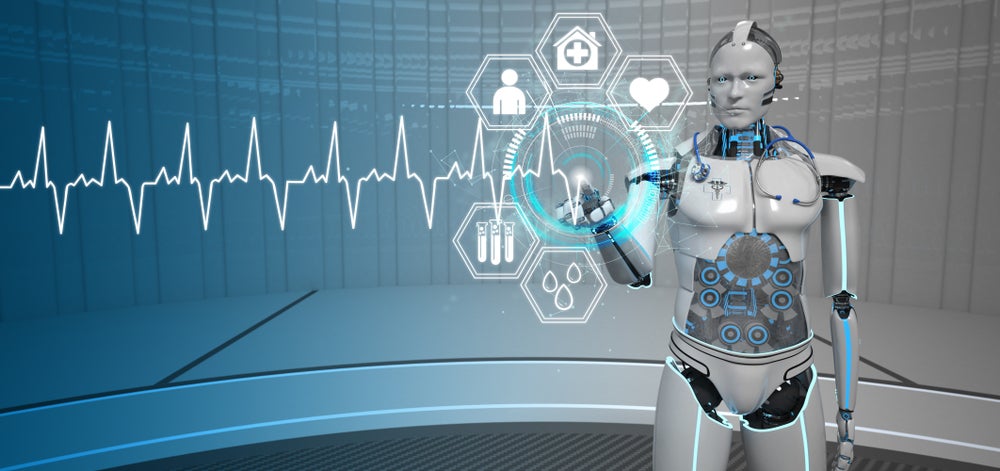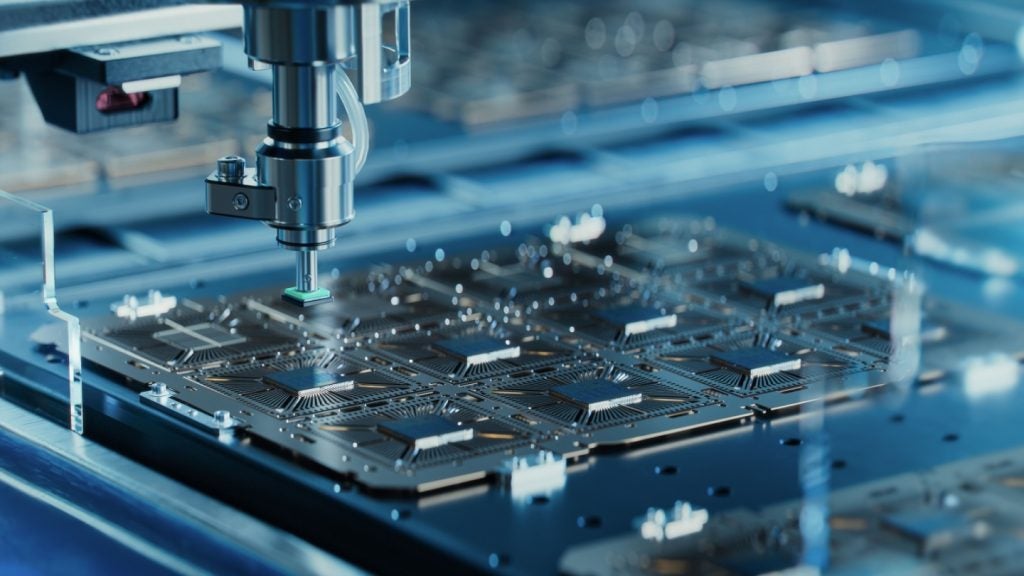The technology industry continues to be a hotbed of innovation, with activity driven by progress in robotics technology, characterised by enhancements in sensors, machine learning, and artificial intelligence. It propels the creation of robots with superior capabilities and versatility, thereby growing importance of technologies such as cameras, image processing, object detection and recognition, and deep learning and neural networks. The field of robotic vision is constantly evolving, and researchers and engineers are continuously exploring new algorithms, sensors, and techniques to enhance the visual perception capabilities of robots. In the last three years alone, there have been over 3.6 million patents filed and granted in the technology industry, according to GlobalData’s report on Innovation in Robotics: Robotic vision. Buy the report here.
However, not all innovations are equal and nor do they follow a constant upward trend. Instead, their evolution takes the form of an S-shaped curve that reflects their typical lifecycle from early emergence to accelerating adoption, before finally stabilising and reaching maturity.
Identifying where a particular innovation is on this journey, especially those that are in the emerging and accelerating stages, is essential for understanding their current level of adoption and the likely future trajectory and impact they will have.
300+ innovations will shape the technology industry
According to GlobalData’s Technology Foresights, which plots the S-curve for the technology industry using innovation intensity models built on over 2.5 million patents, there are 300+ innovation areas that will shape the future of the industry.
Within the emerging innovation stage, AI-assisted inspection, anti-collision LiDAR, and 3D object sensing are disruptive technologies that are in the early stages of application and should be tracked closely. Autonomous harvesters, cleaning robots, and line follower robots are some of the accelerating innovation areas, where adoption has been steadily increasing. Among maturing innovation areas are, welding robot and robotic vision, which are now well established in the industry.
Innovation S-curve for robotics in the technology industry

Robotic vision is a key innovation area in robotics
Robotic vision refers to the technological capability that enables robots to comprehend their surroundings using cameras, sensors, and algorithms. This capability empowers robots to recognize and interpret objects within their environment, subsequently enabling them to respond and adapt accordingly.
GlobalData’s analysis also uncovers the companies at the forefront of each innovation area and assesses the potential reach and impact of their patenting activity across different applications and geographies. According to GlobalData, there are 10+ companies, spanning technology vendors, established technology companies, and up-and-coming start-ups engaged in the development and application of robotic vision.
Key players in robotic vision – a disruptive innovation in the technology industry
‘Application diversity’ measures the number of different applications identified for each relevant patent and broadly splits companies into either ‘niche’ or ‘diversified’ innovators.
‘Geographic reach’ refers to the number of different countries each relevant patent is registered in and reflects the breadth of geographic application intended, ranging from ‘global’ to ‘local’.
Patent volumes related to robotic vision
| Company | Total patents (2010 - 2022) | Premium intelligence on the world's largest companies |
| Kawasaki Heavy Industries | 239 | Unlock Company Profile |
| Causam Energy | 42 | Unlock Company Profile |
| Qualcomm | 14 | Unlock Company Profile |
| Medicaroid | 14 | Unlock Company Profile |
| iRobot | 9 | Unlock Company Profile |
| Johnson Controls International | 8 | Unlock Company Profile |
| LG | 8 | Unlock Company Profile |
| Toyota Motor | 7 | Unlock Company Profile |
| Gree Electric Appliances | 6 | Unlock Company Profile |
| Alphabet | 6 | Unlock Company Profile |
| Brain | 6 | Unlock Company Profile |
| Honeywell International | 5 | Unlock Company Profile |
| Vorwerk | 5 | Unlock Company Profile |
| Toshiba | 5 | Unlock Company Profile |
| Beijing Electronics | 5 | Unlock Company Profile |
Source: GlobalData Patent Analytics
Kawasaki Heavy Industries is one of the leading patent filers in robotic vision. One of the company's patents aims to improve a remote-control robot system with multiple slave arms. The slave arms have different control modes: automatic, manual, and correctable automatic. The system allows the operator to correct the automatic operation while ensuring that the selected control modes of the slave arms do not overlap in time. Other prominent patent filers in the space include Causam Energy and Qualcomm.
In terms of geographical reach, Toyota Motor leads the pack, followed by Kawasaki Heavy Industries and Vorwerk. In terms of application diversity, Toyota Motor holds the top position, followed by iRobot and Johnson Controls International.
Robotic vision revolutionizes the capabilities of robots, enabling them to perceive, understand, and interact with the world in ways that were previously limited to human perception. Its significance lies in its ability to enhance automation, safety, efficiency, adaptability, and decision-making capabilities, thereby opening new frontiers for robotics in various industries and applications.
To further understand how robotics is disrupting the technology industry, access GlobalData’s latest thematic research report on Robotics – Thematic Research Report.
Premium Insights
From

The gold standard of business intelligence.
Blending expert knowledge with cutting-edge technology, GlobalData’s unrivalled proprietary data will enable you to decode what’s happening in your market. You can make better informed decisions and gain a future-proof advantage over your competitors.







